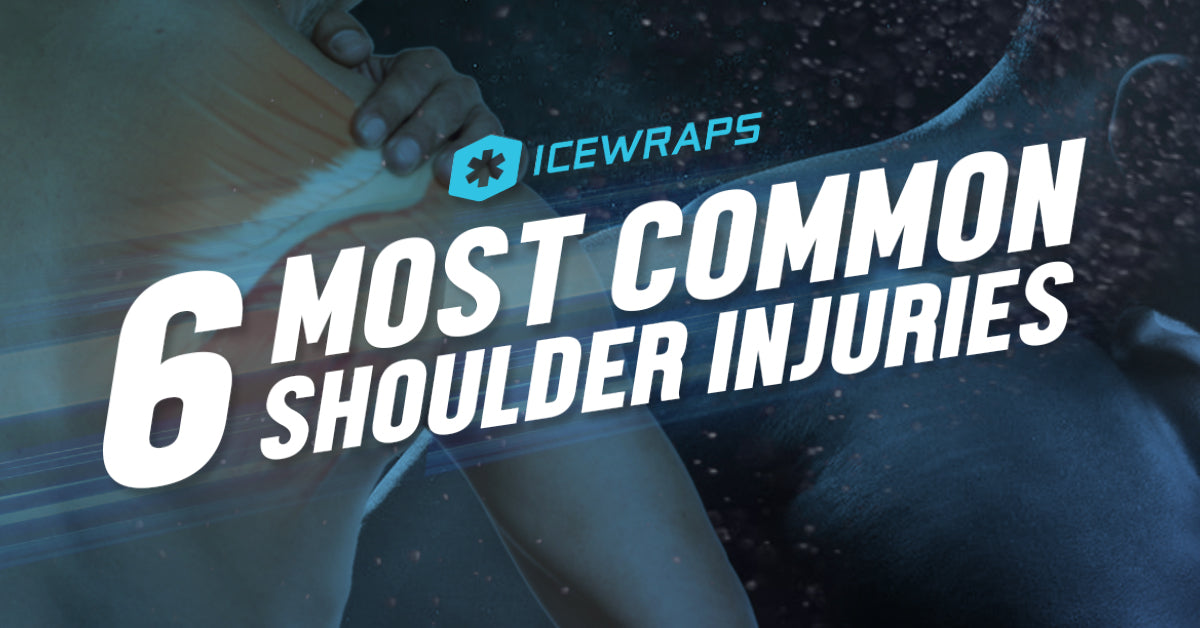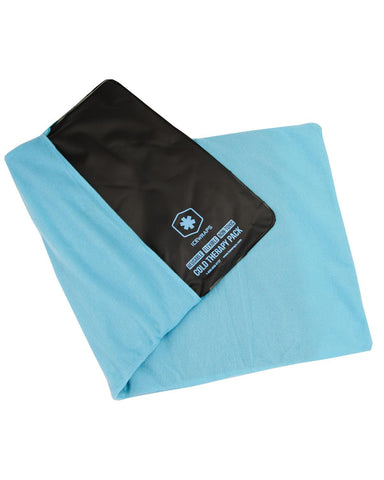Your Cart is Empty

Contents
Are you experiencing shoulder pain after an intense workout?
Feeling a sudden discomfort?
Did you hear a pop that didn’t sound right?
Injuries to the shoulder are inconvenient and painfully common. So common in fact that around 7.5 million cases are reported in a year.
Athletes who play overhead sports like baseball and tennis are most vulnerable to shoulder injuries, as well as anyone whose job may require repetitive and excessive overhead motion.
It pays to be vigilant during the first signs of shoulder pain, so we took the liberty of rounding up six of the most common shoulder injuries and some of the ways you can treat them.
Other things your shoulder pain might be telling you
A word of warning though– shoulder pain does not always mean a shoulder injury. Before we dive deeper into the common shoulder injuries, you should know a thing or two about referred pain.
Referred pain is discomfort that could be indicative of other conditions. If you can’t pinpoint the cause of your shoulder pain, it can mean that there is an issue somewhere else in the body.
Some of the conditions that may refer pain to the shoulders are linked to the abdomen or pelvis such as gallstones, pancreatitis, or a ruptured ovarian cyst. Diseases affecting the lungs, such as pneumonia can also manifest pain in the shoulder area, and a heart attack usually starts in the left arm and shoulder.
How to confirm if it's a shoulder injury
Nothing beats visiting your physician when it comes to diagnosing an injury. However, there are a few exercises to help you figure out if your trusty shoulders have been compromised.
We promised you a roundup of the most common shoulder injuries so here they are.
From accidents, overuse, to acute injuries, we've lined up the most common shoulder injuries and a few tips on how to manage them.

Shoulder strains and sprains occur when the shoulders are overstretched or torn. Sprains and strains may sound alike, but the difference between a shoulder strain and a sprain is in the location of the damage. A strain is a stretch or tear in the muscle and tendons, while a sprain is a stretch or tear in the ligaments.
Still a little confused between muscles, tendons, and ligaments? Here’s an in-depth shoulder anatomy guide to help you out.
Overstretching your shoulders can be caused by lifting objects which are heavier than you’re able to, or overworking your shoulders in sports. Tears, on the other hand, happen when your arms are forced backwards or when your shoulders are directly hit - like falling from a step ladder or hitting your shoulders against a pole.
Signs to watch out for:
What to do:
When dealing with shoulder injuries, there’s five things you need to keep in mind. Luckily, it’s easy to remember when you use the mnemonics PRICE, which stands for: Protect, Rest, Ice, Compression, and Elevate.
Protect. Protect the injured area from any further damage by avoiding strenuous activities or using any form of support if necessary. When sleeping, avoid putting weight on your injured shoulder, or support it with pillows.
Rest. Rest is king when it comes to treating any injury. After overworking your shoulders, you must give it ample time to recover. That means you should take a few days off from training, lifting weights, or performing activities that may put you at risk for another injury.
Ice. Cold therapy (or cryotherapy if you’re feeling technical) works by restricting blood flow to the inflamed area eventually reducing any signs of inflammation. Applying an ice pack also relieves pain for a period of time by reducing nerve activity in the area. Using an ice pack for first aid treatment is generally safe, but make sure to properly gauge if the surface is too cold for your skin as it may lead to frostbite in some cases. It is recommended to wrap the pack in a piece of fabric to serve as a barrier between the pack and your skin.
Should you use a hot therapy pack? Cold compress works best for inflammation, while hot or warm compress works best for muscle stiffness. If you’re still a little confused with which one to use, you can quickly run through this guide to find out more.
Compression. Compression by using elastic bandages are helpful for the first 24 to 48 hours of the injury. Compressing your injured shoulders limits the swelling of the sprain or strain. After the first 2 days however, blood flow needs to go back to normal.
Keep in mind to wrap your injury comfortably and not too tight. The goal is to limit the blood flow to the inflamed area, not to cut it off altogether.
Elevation. Elevating your shoulders above the heart minimizes swelling by moving fluids away. Do this along with the methods previously mentioned and the pain should be manageable within 72 hours.
Aside from P.R.I.C.E., taking non-steroidal anti-inflammatory drugs (NSAIDs) like Ibuprofen (Advil, Motrin) or Acetaminophen (Tylenol) work well to soothe inflammation and to manage pain.
A fracture is any damage to the shoulder's main bones - clavicle, scapula, and humerus.
Generally speaking, a fracture can fall into two categories:
Non-displaced fractures are fractures where the bones remain in their anatomical position. This type of fracture is usually treated by immobilization until the bone fragments heal.
On the other hand, displaced fractures are fractures where the bone fragments are not in their anatomical position. Displaced fractures may require some type of adjustments such as surgery, the use of metal plates, or a brace to reinstate it to its original position.
Interestingly enough, fractures to the humerus and clavicle are more common than fractures of the scapula. With the size of the scapula and all the muscles surrounding and supporting it, it sure takes a high-impact trauma such as a vehicular accident to fracture this bone.
Are you suspecting a fracture? Here are a few signs to watch out for:
What to do:
Once a fracture occurs, evaluate the severity of the fracture and call for help in cases of emergency. If the accidents that cause the fracture are unthreatening, there are first aid treatments you can apply to manage the pain.
First, you need to immobilize the injured area and gently apply an ice pack right above or below the fracture until further treatment can be given. The ice pack soothes any inflammation and temporarily relieve pain.
After applying first aid, it is important to consult a doctor to find out whether your fracture is displaced or non-displaced. Knowing this will determine the proper treatment plan for your injury.
The rule of thumb to treating fractures is to keep it immobile. Doing this prevents any further damage to the bones by giving it ample protection to allow the fragments to heal. While in recovery, you may be advised to wear a sling or take pain medication by your physician. In more advanced cases, your physician might require surgery.
The shoulder joint is the most frequently injured joint of the body. Aside from the fact that it's the most mobile joint, the humerus (long arm) is also longer than its socket (glenoid cavity), which makes it structurally unstable.
There are two types of shoulder dislocations: subluxation and complete dislocation.
Partial dislocation or subluxation is when the shoulder joint partially slides out of place. On the other hand, complete shoulder dislocation is when the joint is entirely out of place.
Partial dislocations are more common, while it takes high-impact circumstances, such as extreme rotation of the shoulders or a terrible accident, to completely dislocate your shoulders. Whether they’re partial or complete dislocations, seek treatment as soon as possible since these could lead to more serious conditions.
The tricky thing about dislocations is that once you’ve experienced one, your shoulders become more susceptible to another. When dislocations occur frequently, it can lead to what we call shoulder instability.
Shoulder instability occurs when the structures that surround the shoulder joint lose their integrity and as a result, lose their ability to secure the ball within its socket.
Signs to watch out for:
What to do:
The first step to healing shoulder instability is by restricting movement. Immobilizing your shoulders allows the tendons and muscles to heal. Plus, it also prevents further damage.
To manage inflammation, you take non steroidal anti-inflammatory drugs (NSAIDs) or can use cold therapy packs to the affected area.
IceWraps.com has a wide range of ice packs and compression therapy wraps specifically made for shoulders. These packs provide the cold therapy that you need while giving your shoulders optimum support and restraint.
After you’ve managed the pain from your injury, physical therapy is helpful to restore your shoulder’s range of motion.
In any case that a sport or activity is causing your shoulder's dislocation or instability, it might be time to evaluate how you can prevent hurting your shoulders furthermore or in the future.
Pain caused by shoulder impingement is persistent and annoying. It happens when tendons or the bursae, which are fluid-filled sacs near the joint, are impinged by the bones.
Overhead activities and sports such as baseball, tennis, volleyball are usual culprits to shoulder impingement. When not treated immediately, this may lead to a more advanced condition like bursitis.
Signs to watch out for:
What to do:
Conservative treatment like P.R.I.C.E. can help with shoulder impingement.
Resting the shoulders is necessary, but don't make the mistake of using a sling to keep it immobile as this can lead to more weakness in the arm. Instead, physical therapy will be more helpful to regain the shoulders' strength and range of motion.
For some advanced cases, surgery might be necessary for treating shoulder impingement.
The rotator cuff tendons cover the head of the humerus or the upper arm bone. They are responsible for securing the ball of the upper arm bone into the shallow socket of the shoulder, as well as arm movement.
Since they’re highly mobile, the rotator cuff can tear partially or completely - in which case the tendon becomes completely separated from the bone.
Rotator cuff injuries are degenerative injuries, which means they’re most likely caused by overuse.
Signs to watch out for:
When left untreated, rotator cuff tears can progress into rotator cuff arthropathy, which is shoulder arthritis, paired with a rotator cuff tear.
When the rotator cuff degenerates, the arm bone is unprotected from rubbing with the socket, resulting in pain and weakness.
Signs to watch out for:
What to do:
P.R.I.C.E. is still the basic treatment for rotator cuff injuries. However, you must consult with your doctor should the pain persist. Depending on your condition’s severity, steroid injections, physical therapy, and operational procedures are valid options.
Some operational procedures on rotator cuff injuries are:
Bursitis is the inflammation of the bursae. The bursae are fluid-filled sacs that cushion the bones, tendons, and muscles near the joints. They basically allow the rotator cuff tendons to glide freely.
When the rotator cuff tendons are injured or damaged, this bursa can also become inflamed and painful.
Signs to watch out for:
What to do:
Still, conservative treatments (P.R.I.C.E.) and taking NSAIDs for inflammation usually takes care of bursitis. However if your bursitis is caused by an infection, your physician may prescribe antibiotics.
For bursitis, physical therapy is important in order to revive your shoulders’ strength and range of motion. Should the pain become difficult to manage, assistive devices such as canes can relieve pressure on the affected area.
Diagnosing your injuries early on can be helpful for your overall shoulders' health.
Shoulder injuries aren’t inevitable. In the case that you do hurt your shoulders, it is crucial to know the conservative treatments you can apply instantly.
Remember PRICE (Protect, Rest, Ice, Compress, Elevate) and take medications to manage pain when necessary.
You can check out our product list here if you’re on the market for ice packs or compression therapy packs. Pain relief is one click away!

|
 |
| ICEWRAPS EXTRA LARGE NECK ICE PACK WITH SOFT COVER | ICEWRAPS 12X21 OVERSIZE COLD THERAPY CLAY PACK WITH COVER |
 |
 |
Comments will be approved before showing up.